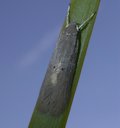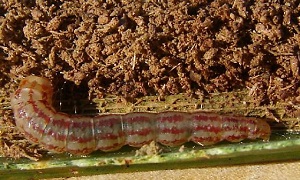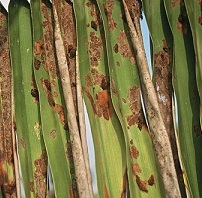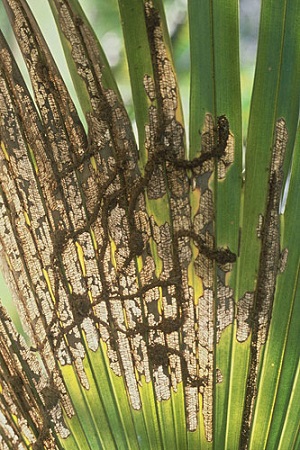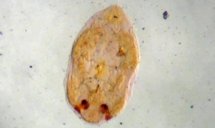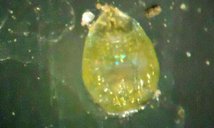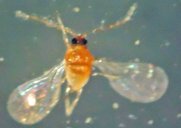| Coconut Palm Pests | ||||||||||||||||||||||||||||||||||
|---|---|---|---|---|---|---|---|---|---|---|---|---|---|---|---|---|---|---|---|---|---|---|---|---|---|---|---|---|---|---|---|---|---|---|
| Back to Coconut Page 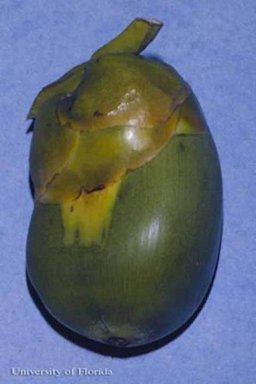 Fig. 1
Fig. 1Early damage to a young coconut by Aceria guerreronis Keifer, a coconut mite. Note the pale triangular area. 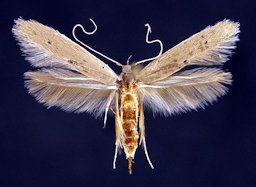 Fig. 6  Palm leaf skeletonizer adult 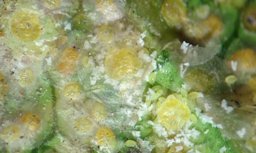 Fig. 12 Fig. 12  Coconut scale, Aspidiotus destructor Signoret, showing eggs, nymphs and exuviae, and adult female with cover removed 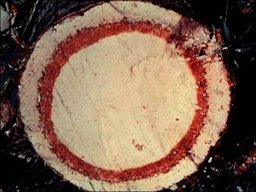 Fig. 18
Fig. 18The telltale red ring seen here in a cross-section of a palm indicates that this particular tree is infested by red ring nematode, Bursaphelenchus cocophilus.
|
A number of pests, including several kinds of scale, palm aphid, spider
mites, mealybugs, palm weevils and caterpillars, are occasionally
found, but usually do not require control measures. Nematodes may infest this palm. Coconut Mite Aceria guerreronis Keifer (Fig.1) The coconut mite, Aceria guerreronis, attacks young fruits of the coconut palm, Cocos nucifera L., to which it is almost exclusively confined. It is one of the worst arthropod pests of coconut palm, whether grown as a crop tree or as an ornamental and is the only eriophyid mite that is a serious pest of coconut palm. It is distributed in many tropical countries where coconuts grow. In Florida it is very prevalent on coconut palms on the Florida Keys and occurs sporadically on the mainland. 1 The vernacular name coconut mite has also been applied to both A. trymatus and Raoiella indica Hirst (Tenuipalpidae) in addition to A. guerreronis. The latter species, which is highly destructive to coconut palm foliage, is native to Southern Asia but was recently found in several islands of the Caribbean, and thus is a threat to coconut palms in Florida and throughout the region. 1
Fig. 2. Early damage in a broader area to a young coconut by A. guerreronis, a coconut mite Fig. 3. Coconuts with damage by coconut mite, A. guerreronis Fig. 4. A Red Spicata Dwarf coconut palm, C. nucifera L., with damage from A. guerreronis Fig. 5. Coconut mite damage on fruits of coconut Further Reading A Coconut Mite, Aceria guerreronis Keifer, University of Florida pdf Palm Leaf Skeletonizer (Fig. 6) Homaledra sabalella (Chambers) Caterpillars feed on the upper and lower leaf surfaces, producing large quantities of "frass" that is often the first conspicuous sign of infestation. Tissue between the leaf veins is usually the preferred food, whereby the veins remain intact giving the leaf a skeltetonized appearance. In Florida, larvae are present throughout the year and complete five generations per year in northern Florida. If you suspect palm leaf skeletonizers, call your local UF/IFAS Extension Agent.
Fig. 7. Adult Fig. 8. Early instar larva Fig. 9. Late instar larva pattern of damage by this insect is different on palmate vs. pinnate palms: Fig. 10. Damage to C. nucifera (pinnate palm) Fig. 11. Damage to Washingtonia robusta (palmate palm) Further Reading Palm Leaf Skeletonizer, University of Florida, Okeechobee Extension pdf (archived) The Palm Leaf Skeletonizer, Homaledra sabalella (Lepidoptera: Coleophoridae): Status and Potential Pest Management Options, Florida State Horticulture Society pdf Coconut Scale Aspidiotus destructor Signoret (Fig. 12) The coconut scale is among the most damaging of all armored scale insects (Beardsley, 1970). This pest is usually found in densely massed colonies on the lower surfaces of leaves, except in extremely heavy infestations where it may be present on both sides. It may also be found on petioles, peduncles and fruits. Mature scales are found on the older leaves. Infestations are typically associated with yellowing of the leaves in areas where the scales are present. The yellowing is caused by the removal of sap by the sucking mouth parts and the toxic effects of the saliva that kills the surrounding tissues at the feeding site (Waterhouse & Norris, 1987). 3 Coconut scale, A. destructor Signoret (Hemiptera: Diaspididae), is a pest in over 60 plant families and is found globally in tropical and subtropical areas (Davidson and Miller 1990, Ben-Dov 2014). This armored scale was described by Signoret in 1869 and appears to be native to South Asia but has spread around the world, mainly on infested coconut and banana (UK CAB International 1966). The insect feeds on plant sap from leaves, stems and fruits, causing yellowing, tissue distortion and die back. The coconut scale is a pest of concern on coconut and other perennial crops due to its relatively short life cycle of around 35 days and multiple overlapping generations per year. Coconut scale is known to be dispersed by birds, bats and insects as well as wind (Taylor 1935). 3
Fig. 13. Adult female coconut scale, A. destructor, showing eggs under cover Fig. 14. Coconut scale, A. destructor, male pupa removed from cover Fig. 15. Adult female coconut scale, removed from cover Fig. 16. Adult male coconut scale Fig. 17. Underside of mango leaf infested with coconut scale Further Reading Coconut Scale (Aspidiotus destructor Signoret), Agricultural Development in the American Pacific pdf Coconut Scale Aspidiotus destructor Signoret, University of Florida pdf (archived) Red Ring Nematode (Fig.18) Bursaphelenchus cocophilus B. cocophilus causes red ring disease of palms. Symptoms of red ring disease were first described on Trinidad coconut palms in 1905. Red ring disease can appear in several species of tropical palms, including date, Canary Island date and Cuban royal, but is most common in oil and coconut palms. The red ring nematode parasitizes the palm weevil Rhynchophorus palmarum L., which is attracted to fresh trunk wounds and acts as a vector for B. cocophilus to uninfected trees. 4 Although B. cocophilus and R. palmarum are not found in Florida, some other potential beetle vectors of the red ring nematode, Metamasius hemipterus and Rhynchophorus cruentatus, are common in Florida. If the nematode were introduced to Florida, an epidemic could potentially occur. Therefore, this nematode is of great regulatory concern. 4
Fig. 19. Smaller-than-usual and dying leaves are one of the symptoms of red ring disease, caused by the red ring nematode B. cocophilus Fig. 20. The palm weevil Rhynchophorus palmarum acts as the primary vector for red ring nematode, B. cocophilus, which causes red ring disease in coconut and oil palms Further Reading Red Ring Nematode, Bursaphelenchus cocophilus (Cobb) Baujard formerly Rhadinaphelenchus cocophilus, University of Florida pdf (Archived) |
|||||||||||||||||||||||||||||||||
| Bibliography 1 Howard, F. W., and Dave Moore. "A Coconut Mite, Aceria guerreronis Keifer (Arachnida: Acari: Eriophyidae)." Entomology and Nematology Dept., UF/IFAS, EENY-398 (IN709), Original Pub. Dec. 2006, Revised June 2022, AskIFAS, edis.ifas.ufl.edu/IN709. Accessed 24 Apr. 2017, 16 Mar. 2024. 2 Culbert, Daniel F. "Palm Leaf Skeletonizer." Environmental Horticulture, UF/IFAS, Okeechobee County Extension, 2010, Archived. Accessed 26 Apr. 2014, 16 Mar. 2024. 3 Salahud din, and Steven P. Arthurs. "Coconut Scale Aspidiotus destructor Signoret (Insecta: Hemiptera: Diaspididae)." Entomology and Nematology Dept., UF/IFAS Extension, EENY622, Original Pub. Mar. 2015, Revised May 2021, AskIFAS, Archived, edis.ifas.ufl.edu. Accessed 16 Nov. 2015, 2 Jan. 2024, 16 Mar. 2024. 4 Brammer, A. S., and W. T. Crow. "Red Ring Nematode, Bursaphelenchus cocophilus (Cobb) Baujard (Nematoda: Secernentea: Tylenchida: Aphelenchina: Aphelenchoidea: Bursaphelechina) formerly Rhadinaphelenchus cocophilus." Entomology and Nematology Dept., UF/IFAS Extension, EENY236, Original Pub. Sept. 2001, Rev. Dec. 2018, AskIFAS, edis.ifas.ufl.edu. Archived. Accessed 14 Mar. 2019, 16 Mar. 2024. Photographs Fig. 1 DeFilippis, J. V. "Early damage to a young coconut by A. guerreronis Keifer, a coconut mite. Note the pale triangular area." UF/IFAS, edis.ifas.ufl.edu. Accessed 1 May 2014. Fig. 2 DeFilippis, J. V. "Early damage in a broader area to a young coconut by A. guerreronis Keifer, a coconut mite." UF/IFAS, edis.ifas.ufl.edu. Accessed 1 May 2014. Fig. 3 Howard, F. W. "A Coconut Mite, Aceria guerreronis Keifer (Arachnida: Acari: Eriophyidae)." UF/IFAS, edis.ifas.ufl.edu. Accessed 1 May 2014. Fig. 4 Howard, F. W. "'Red Spicata Dwarf' coconut palm, Cocos nucifera L., with damage from Aceria guerreronis Keifer, a coconut mite." UF/IFAS, edis.ifas.ufl.edu. Accessed 1 May 2014. Fig. 5 Broschat, T. K. "Coconut mite damage on fruits of coconut." Symptoms of Palm Diseases and Disorders, USDA APHIS ITP. 2012, UF/IFAS, (CC BY-NC 3.0 US), bugwood.org. Accessed 1 May 2014. Fig. 6 Vargo, Jim. "Palm Leaf Skeletonizer Adult, Mississippi State University, Mishawaka, Indiana." North American Moth Photographers Group, Missisippi Entomological Museum at Missisipi State University, mothphotographersgroup.msstate.edu/AboutMPG.shtml. Accessed 9 Oct. 2017. Fig. 7 Hollenbeck, Jeff. "Palm Leaf Skeletonizer." Screening Aid to Pests, A Resource for Pests and Diseases of Cultivated Palms, 2010, itp.lucidcentral.org/id/palms/resource/index.html. Accessed 26 Apr. 2014. Fig. 8 Hollenbeck, Jeff. "Palm Leaf Skeletonizer." Screening Aid to Pests, A Resource for Pests and Diseases of Cultivated Palms, 2010, itp.lucidcentral.org/id/palms/resource/index.html. Accessed 26 Apr. 2014. Fig. 9 White, Machele. "Palm Leaf Skeletonizer." Screening Aid to Pests, A Resource for Pests and Diseases of Cultivated Palms, 2010, itp.lucidcentral.org/id/palms/resource/index.html. Accessed 26 Apr. 2014. Fig.10 Howard, F. W. "Palm Leaf Skeletonizer Damage to C. nucifera (pinnate palm)." Screening Aid to Pests, In A Resource for Pests and Diseases of Cultivated Palms, 2010, itp.lucidcentral.org/id/palms/resource/index.html. Accessed 26 Apr. 2014. Fig. 11 Howard, F. W. "Palm Leaf Skeletonizer Damage to Washingtonia robusta (palmate palm)." 2010. Screening Aid to Pests, In A Resource for Pests and Diseases of Cultivated Palms, 2010, itp.lucidcentral.org/id/palms/resource/index.html. Accessed 26 Apr. 2014. Fig. 12 Salahud din. "Coconut scale, Aspidiotus destructor Signoret, showing eggs, nymphs and exuviae, and adult female with cover removed." UF/IFAS, edis.ifas.ufl.edu. Accessed 1 May 2014. Fig. 13 Salahud din. "Adult female coconut scale, Aspidiotus destructor Signoret, showing eggs under cover." UF/IFAS, edis.ifas.ufl.edu. Accessed 1 May 2014. Fig. 14 Salahud din. "Coconut scale, Aspidiotus destructor Signoret, male pupa removed from cover." UF/IFAS, edis.ifas.ufl.edu. Accessed 1 May 2014. Fig. 15 Salahud din. "Coconut scale, Aspidiotus destructor Signoret, female pupa removed from cover." UF/IFAS, edis.ifas.ufl.edu. Accessed 1 May 2014. Fig. 16 Salahud din. "Adult male coconut scale, Aspidiotus destructor Signoret." UF/IFAS, edis.ifas.ufl.edu. Accessed 1 May 2014. Fig. 18 "The telltale red ring seen here in a cross-section of a palm indicates that this particular tree is infested by red ring nematode, Bursaphelenchus cocophilus." Society of Nematologists slide collection, edis.ifas.ufl.edu. Accessed 13 May 2014. Fig. 19 "Smaller-than-usual and dying leaves are one of the symptoms of red ring disease, caused by the red ring nematode Bursaphelenchus cocophilus." Society of Nematologists slide collection, edis.ifas.ufl.edu. Accessed 13 May 2014. Fig. 20 Zunke, Ulrich. "The palm weevil Rhynchophorus palmarum acts as the primary vector for red ring nematode, B. cocophilus, which causes red ring disease in coconut and oil palms." University of Hamburg, edis.ifas.ufl.edu. Accessed 13 May 2014. Published 1 May 2014 LR. Last update 16 Mar. 2024 LR |
||||||||||||||||||||||||||||||||||




